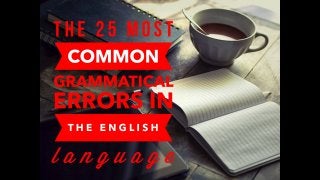
Gold for sale and diamond +27835410199 in Uganda, Congo, Sudan
- 1. A blank canvas an author’s
- 2. How to use Self-edit Before you publish, make sure you aren’t making these common mistakes. Keep track Notice the mistakes you make; soon you’ll be able to avoid them easily. Get better Once you master these common mistakes, you can start writing better without worrying about making little mistakes. THIS GUIDE
- 3. THE USE OF ”whom” and “who” ★ Who = subjective pronoun, like “he,” “she,” “it” – acts as a subject. ★ Whom = objective pronoun, like “him,” “her” “us” 1
- 4. THE USE OF “lay” and “lie” ★ Lay – transitive verb; needs a direct subject and an object. ★ Lie – intransitive verb and needs no object. 2
- 5. CONTINUAL & “Continuous” ★ Continual = something is constantly occurring, but with lapses in occurrences. ★ Continuous = something that continues without any stops or gaps. 3
- 6. THE USE OF “whether” and “if” ★ Whether = conditional; used when there are two or more alternatives ★ If = no alternatives 4
- 7. THE USE OF “farther” and “further” ★ Farther = used for physical distance. ★ Further = used for abstract lengths. 5
- 8. THE USE OF ★ Disinterested = someone who is impartial. No bias. ★ Uninterested = someone who really just couldn’t care less. 6 “disinterested” and “uninterested”
- 9. THE USE OF “since” and “because” ★ Since = time-related.. ★ Because = cause related.. 7
- 10. THE USE OF “bring” and “take” ★ Bring = moving an object towards something. ★ Take = moving an object away from something.. 8
- 11. THE USE OF “affect” and “effect” ★ Affect = almost always a verb; means to influence.. ★ Effect = usually describes the result or an outcome. In some cases, is used as a transitive verb.. 9
- 12. THE USE OF “i.e.” and “e.g.” ★ I.e. = you are describing the essence of something.. ★ E.g. = basically used for listing down or enumerating examples.. 10
- 13. THE USE OF “which” and “who” ★ Which = refers to object/non-humans.. ★ Who = refers to humans.. 11
- 14. THE USE OF “your” and “you’re” ★ Your = Possessive. Your dog, your bag, your car. ★ You’re = You + are. Describes a state of being. You’re a doctor. You’re a teacher. You’re a child. 12
- 15. THE USE OF ”they’re” “there” “their” ★ They’re = they + are. Describes a state of being. They’re cooking. ★ There = location of something., I live there. I eat there. You work there. ★ Their = possessive. Their dog. Their house. Their apples.. 13
- 16. THE USE OF “it’s” and “its” ★ It’s – It + is. Describes a state of being. It’s a boy. It’s running. ★ Its – Possessive. Its tail, its eyes, its whiskers. 14
- 17. THE USE OF “me” & “I” ★ I = Subject. Like he, she and it. ★ Me = Objective pronoun, similar to him, her, them. 15
- 18. THE USE OF “peek” , “peak” , “pique” ★ Peek = you take a quick look at something. ★ Peak = the highest point of something, the peak of a mountain. ★ Pique = to provoke something. 16
- 19. THE USE OF “complement” & “compliment” ★ Complement = something that completes or enhances something else. ★ Compliment = an expression of admiration for something or someone. 17
- 20. THE USE OF ★ Between = used when something is in the middle of two things. ★ Among = being located within a group of things. 18 “between” and “among”
- 21. THE USE OF “then” and “than” ★ Then = used when you are situating events in time.. ★ Than = used for comparisons. 19
- 22. THE USE OF “could of” | “would of” | “should of” ★ All of them are wrong. Correct = could have, would have, should have. ★ Further = used for abstract lengths. 20
- 23. THE USE OF “two” | “to ”| “too” ★ Two = Two dogs. Two cows. Two hands. ★ Too = As well. ★ To = Used for infinitive forms of verbs. To eat, to sleep, to breathe. 21
- 24. THE USE OF “irregardless” and “unthaw” ★ These words do not exist. They do not need prefixes to express what they are defining. 22
- 25. THE USE OF “a lot” ≠ “alot” | “allot” ★ Allot = means to assign. ★ A lot = means there are many. ★ Alot = is not a word.. 23
- 26. THE USE OF “loose” and “lose” ★ Loose = something is not tight. ★ Lose = means to misplace something. 24
- 27. THE USE OF subject-verb agreement ★ “The use of pencils is required for the exam.” ★ “The problems of that boy are pressing.” 25
- 28. T H A N K S B R O U G H T T O Y O U B Y www.bookbutchers.com